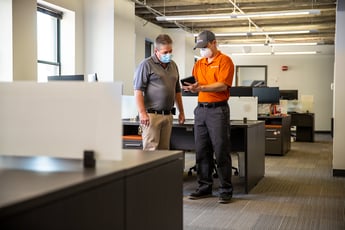
You think your fire code compliance is in order. Everything is managed, maintained, and inspected according to the schedules and protocols. Your company has gone almost a year without any issues. You're on top of the world. Enter COVID-19, a global pandemic.
COVID-19 has made companies think twice about fire and life safety. This is the story of how COVID-19 has impacted dormant fire code compliance issues and introduced ones that weren’t even on the radar for many companies.
Entry for Inspections - Not So Fast
At the start of the pandemic, the world was thrown into an unprecedented situation it wasn’t prepared to handle. Many businesses closed. Most didn’t know how to adapt to social distancing. For businesses that remained open, they denied entry to guests. Schools turned to remote learning. No one was allowed inside regardless of who you were. This went on for months. But as state orders were modified, buildings opened back up. Entry into them to conduct the required fire and life safety inspections and tests were becoming less restrictive.
Although most are open today, there remain several occupancy classifications in which entry is still difficult, if not impossible. These reside in health care and residential occupancies. As an example, multifamily dwellings allow for entry into common areas or electrical or riser rooms, but no entry to individual units. Thus, per the NFPA 72, inspection or test can be deferred for up to 18 months if equipment is in a hazardous location.
A survey of building and fire code officials from different construction and fire departments conducted within the first month of the pandemic by the International Code Council (ICC) gave a sobering picture of how fire code inspections and compliance were at a critical moment. The main goal of the survey was to learn how code officials were coping with the professional challenges brought on by the COVID-19 pandemic. Some of the data collected looked at trends, ideas, solutions and best practices from code officials about how they are keeping up with new building permits, new construction, amendments to fire code and more during the pandemic months. The survey heard from 1,100 people from all 50 states.
Some of the critical findings were as follows:
- 93% of the building and fire prevention departments surveyed were still performing inspections; either remotely or in-person
- 26% of building and fire code officials encountered requests for permits for temporary occupancy and/or temporary structures as a result of COVID-19
- 65% of respondents said some or all employees who conduct the company’s fire code and compliance plan review or inspections were currently working remotely thus, creating an issue to address compliancy issues onsite when the fire code inspector arrived.
Inspections are critical to maintaining and keeping buildings and their people safe. In order to do that, fire code inspectors had to adjust, as did building owners and managers. COVID-19 provided a whole new battle for inspectors.
You Get Sanitizer! You Get Sanitizer! Everyone Gets Sanitizer!
While entry into buildings to conduct inspections and maintenance is one of the biggest issues to rise from COVID-19, another challenge in the fire safety world was the storage and use of sanitizer, or alcohol-based hand-rub (ABHR). Due to how flammable ABHR is, these products were already regulated by fire and safety codes. But once worldwide guidance on frequently utilizing sanitizer was announced, this became a whole new ballgame.
Amid the pandemic, opened businesses kept sanitizer at entrances, around the office, etc. It was required by state mandates. The CDC guidelines recommended it be used whenever and wherever possible. So, most places that never housed sanitizer were getting a very quick lesson and had to adapt to a whole new set of fire code requirements, including finding correct storage dispensers to hold the sanitizer.
The specific Code that addresses ABHR also addresses the requirements for the location of ABHR dispensers and limits on how much sanitizer can be in use and in storage. The main goal is keeping hazards low. Refer to the following codes for details: NFPA 30, NFPA 101, and NFPA 1.
All the Moving Pieces, and Buildings
Sanitizer wasn’t the only fire code issue that COVID-19 highlighted. Mentioned in the survey above, code inspectors had to deal with new developments and temporary construction to house the sick and address the rising needs throughout many states. This raised a new level of building blocks to navigate.
Makeshift hospitals and morgues were popping up everywhere. As fast as they were being built, they filled even quicker. All new construction, renovated buildings, etc. needed new fire protection systems. They also needed to meet the fire code requirements. With time and resources already scarce, keeping these buildings up to code to protect the lives within was a major strain. Fire protection professionals needed to work efficiently to install new systems or update current ones for the codes to be met in that specific dwelling.
These issues were particularly daunting in the first few months of the pandemic. Fire code inspectors were adjusting to needs hourly. Temporary health care facilities needed to open and operate in a matter of days and thanks to the fire code inspectors, most did.
The challenges mentioned throughout this blog are everyday items fire code inspectors face. They can become overwhelming, especially during a global pandemic. COVID-19 brought a new array of issues to address and consider.
Everyone had to adjust to a new normal, including those who handle fire code compliance. A year later, COVID-19 has opened the eyes of the fire protection industry, inspectors, and those managing their company’s fire and life safety systems. Businesses who have had to adjust in the blink of an eye to stay compliant.
The effects and ramifications from COVID-19 have forever changed fire code and compliance. Going forward, people will be more cognizant of fire code compliancy. They now know the critical eye that needs to view the fire and safety protocols and systems within their buildings so they can plan and prepare in the event of future emergencies. Now more than ever are we reminded of the importance of fire and life safety, and the hard work it takes to ensure compliancy.




